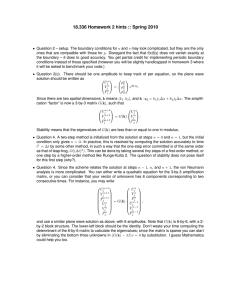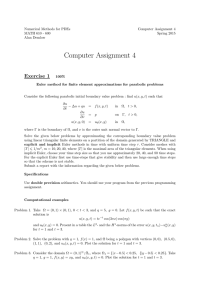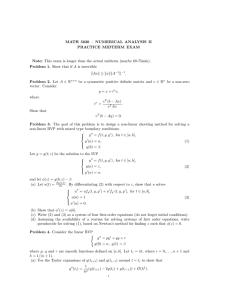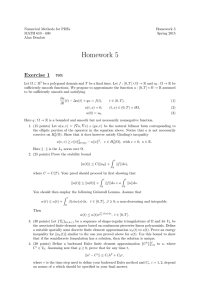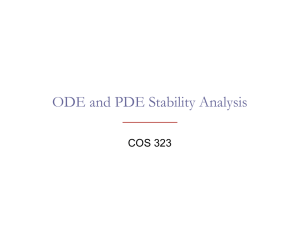Num Soln of DEs: 08: PDEs and the method-of-lines Time-step restrictions
advertisement
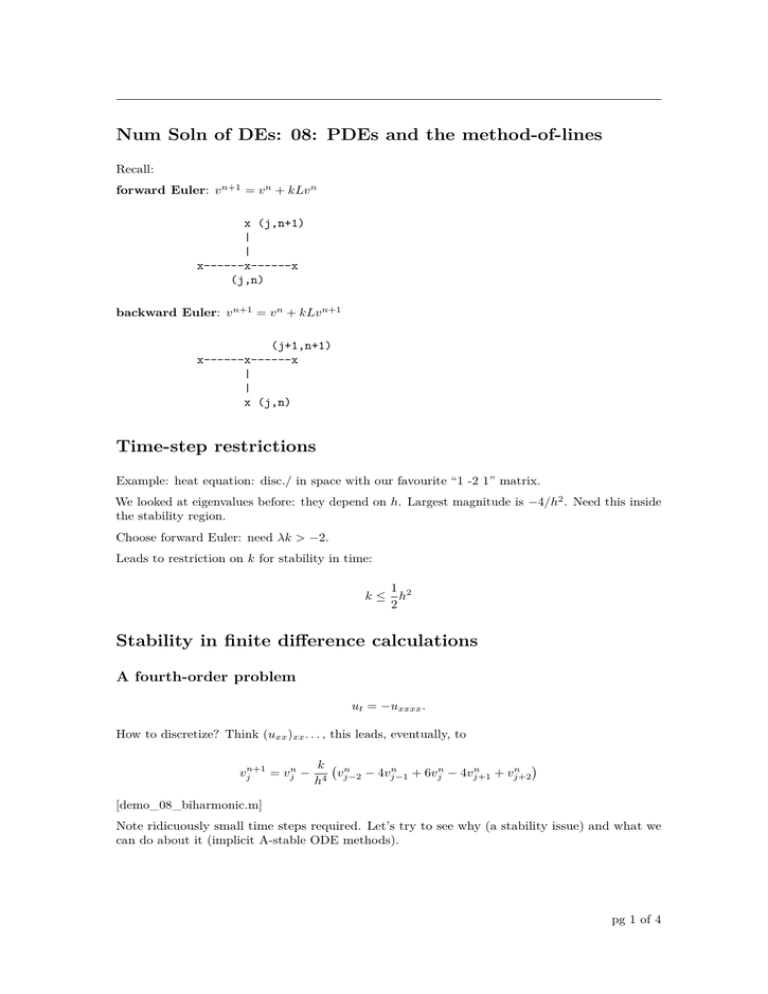
Num Soln of DEs: 08: PDEs and the method-of-lines Recall: forward Euler: v n+1 = v n + kLv n x (j,n+1) | | x------x------x (j,n) backward Euler: v n+1 = v n + kLv n+1 (j+1,n+1) x------x------x | | x (j,n) Time-step restrictions Example: heat equation: disc./ in space with our favourite “1 -2 1” matrix. We looked at eigenvalues before: they depend on h. Largest magnitude is −4/h2 . Need this inside the stability region. Choose forward Euler: need λk > −2. Leads to restriction on k for stability in time: k≤ 1 2 h 2 Stability in finite difference calculations A fourth-order problem ut = −uxxxx . How to discretize? Think (uxx )xx . . . , this leads, eventually, to vjn+1 = vjn − k n n n n vj−2 − 4vj−1 + 6vjn − 4vj+1 + vj+2 4 h [demo_08_biharmonic.m] Note ridicuously small time steps required. Let’s try to see why (a stability issue) and what we can do about it (implicit A-stable ODE methods). pg 1 of 4 von Neumann analysis One approach is von Neumann Analysis of the finite difference formula, also known as discrete Fourier analysis, invented in the late 1940s. Suppose we have periodic boundary conditions and that at step n we have a (complex) sine wave vjn = exp(iξxj ) = exp(iξjh), for some wave number ξ. Higher ξ is more oscillatory. We will analysis whether this wave grows in amplitude or decays (for each ξ). For stability, we want all waves to decay. For the biharmonic diffusion equation, we substitute this wave into the finite difference scheme above, and factor out exp(iξh) to get vjn+1 = g(ξ)vjn , with the amplification factor g(ξ) = 1 − k −i2ξh e − 4e−iξh + 6 − 4eiξh + ei2ξh . h4 This can be simplified to: g(ξ) = 1 − 16k sin(ξ h/2). h4 As ξ ranges over various values sin is bounded by 1 so we have 1 − 16k/h4 ≤ g(ξ) ≤ 1. A mode will blow up if |g(ξ)| > 1. Thus for stability we want to ensure |g(ξ)| ≤ 1 for all ξ , i.e., 1 − 16k/h4 ≥ −1, or k ≤ h4 /8. For h = 0.025, as in the Matlab code, this gives k ≤ 4.883e − 08. This matches our experiment convincingly, but confirms that this finite difference formula is not really practical. Method-of-lines As an alternative to von Neumann analysis, we follow the linear stability analysis for the ODE methods. The spatial discretization gives us (numerically anyway) the eigenvalues of the semidiscrete system. Need these eigenvalues to lie inside the absolute stability region of the ODE method. Note: this involves the eigenvalues of the semidiscrete system, not the original right-hand-side of the PDE. Demo: in Matlab, run demo_08_biharmonic, then use eigs to compute ‘largest magnitude’ eigenvalues of the discretized biharmonic operator: need k times these less than 2 for forward Euler stability. Note this gives almost the same restriction as observed in practice (and calulated with von Neumann analysis) pg 2 of 4 Stability, Consistency, Convergence Lax equivalence theorem: for linear PDEs, consistency + stability implies convergence. With a particular notion of stability: Lax-Richtmyer Stability. . . Suppose we have k = 0.4h2 (some fixed relationship). Say we can write our fully-discrete system as U n+1 = B(k)U n + bn (k) where B(k) is a matrix. This is the case for our heat example with “1 -2 1” and forward Euler for example. Defn: Linear method in this form is Lax–Richtmyer stable if ||B(k)n || ≤ CT where CT constant indep of k, n but could depend on final time T . Example: Fisher-KPP Equation Independent 1937 discoveries for biological applications (spread of species): Fisher; Kolmogorov, Petrovsky, and Piscounov ut = uxx + u − u2 . Solutions: traveling waves. Explicit finite difference model is similar to heat equation. Note we have “nonhomogeneous” BCs u(0) = 1, u(20) = 0; the former is implemented by using an extra vector “BC”. [demo_08_fisher_kpp.m] +-| | | | n+1 n | u = u + k * | eps/h^2 | | | | | +-- |-2 1 | | 1 -2 1 | | . . . | . . . | . . . | | 1 -2 1 | | 1 -2 | | | | | | | | | | | | n | u | 1 | | | | | | n | u | N | | | | | | | | | | | + |1/h^2| | | | 0 | | | | . | | . | | . | | | | | | | | 0 | + --+ | | | | 2 | (u -u ) | j j | | | | | --+ BC Accuracy on heat equation Forward and Backward Euler are both consistent with an expected error of O(k) + O(h2 ). discuss w.r.t. stability of each scheme. . . FE: k = O(h2 ) Maybe you only want first-order accuracy, is so, this extra work is wasteful. (Yet another “definition” of stiffness: if your choice of timestep k is motivated by stability rather than accuracy, you are probably dealing with a stiff problem.) pg 3 of 4 Higher-order in time Even if we want second-order perhaps there are better ways, use a better ODE solve: trapezoidal/trapezium rule in time + second order in space. When used on heat equation, this is called “Crank–Nicolson”: v n+1 = v n + k n+1 k n Lv + Lv . 2 2 or Bv n+1 = Av n Note the stencil of this scheme: (j+1,n+1) x------x------x | | x------x------x (j,n) Caution Sometimes hard to tell from numerical convergence study which terms are dominating. Can also do tests to isolate the error components in h and k. pg 4 of 4


